8 Pumpkin Growing Stages [+ Growth Tips!]
Want to know the different pumpkin growing stages before plowing? Find out more from this all-in-one guide about growing this versatile fruit! (Yes, pumpkin is a fruit!)
Pumpkin is a popular ingredient in many health-conscious meals but can double as a delicious drink or dessert! I often look forward to the autumn season to indulge in my favorite pumpkin spice latte.
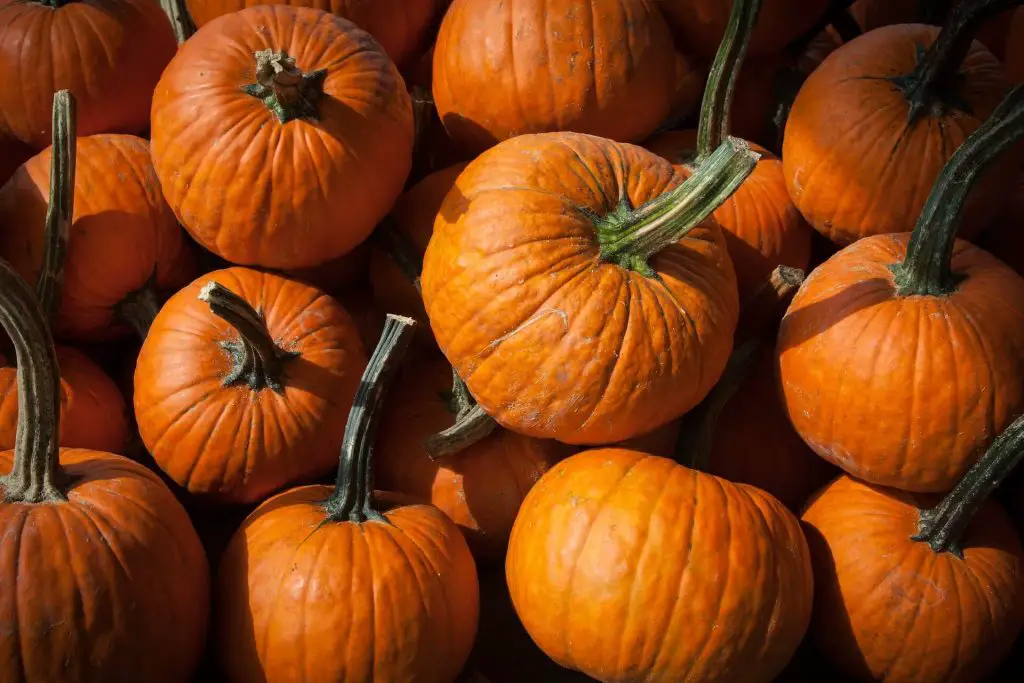
Pumpkin has many benefits and is considered a superfood. It is low in carbohydrates, high in fiber, keto-friendly, and filled with vitamins and minerals.
However, if you do not monitor the pumpkin growth stages, you may have a rotten pumpkin before harvesting! Don’t worry, I have pumpkin plant growth stages pictures to guide you so you will never miss a step.
Read on to identify the pumpkin growth stages timeline so you can have a bountiful of flavorful produce for your pumpkin recipe.
Pumpkin Growing Stages
STAGE 1: Plant The Pumpkin Seeds
STAGE 2: The Beginning Of A New Pumpkin Sprout
STAGE 3: Turning Into New Pumpkin Leaves
STAGE 4: Turning to Fine Vines
STAGE 5: Where Pumpkin Flowers Bloom, So Does Hope
STAGE 6: A Baby Pumpkin Fruit
STAGE 7: Colors Of The Pumpkin
STAGE 8: Harvesting Your Pumpkin
Affiliate Link Disclosure
Some of the links on here are affiliate links and I may earn if you click on them, AT NO EXTRA cost to you. I hope you find the information here useful. Thanks!
Related Posts
- How To Save Pumpkin Seeds For Planting
- Permaculture Gardening For Beginners
- Best Light For Vegetative Growth in 2022
Pumpkin Growing Stages
Packed with plenty of nutrients, pumpkins are easy to grow and harvest! There are 8 pumpkin growing stages.
The first 5 stages focus on the pumpkin plant growing stages, from seed to flower.
The following 3 stages will focus on the growth of the pumpkin fruit. Time to explore the growth cycle of a pumpkin below!

STAGE 1: Plant The Pumpkin Seeds
Always choose high-quality seeds for the best pumpkin growth. I will recommend going to your local nursery to pick up the best pumpkin seeds. You can also save some seeds from your leftover pumpkin fruit but there are no guarantees that these seeds will yield fruitful plants.
If you want to harvest pumpkins as small as the palm of your hand: plant Jack-Be-Little pumpkin seeds.
If you want an all-rounder round pumpkin that is great for carving and eating: pick Autumn Gold or Connecticut Field pumpkin seeds.
If you want a giant pumpkin to admire: choose Big Max pumpkin seeds.
Sow the pumpkin seeds in the ground about 1 to 1 ½ inches deep. Do note that pumpkin vines need plenty of space to sprawl freely. Hence, have at least a 2 feet distance between each seed when planting.
If you prefer to plant it indoors, make sure it is placed near a sunny area with a heating mat, especially during cooler seasons.
STAGE 2: The Beginning Of A New Pumpkin Sprout
The pumpkin seed growth stages are as follows: from seed to germination to sprouting.
Germination, which is when the primary root starts to break out of the seed and dig deep into the soil, will take around ten days. If everything goes well, two leaves will peek out and this is your sprout.

Note that these two round leaves, known as cotyledons, are critical for the next pumpkin plant stages. It will aggressively reach out for sunlight to begin the photosynthesis process so make sure nothing is blocking this seedling from its resources!

STAGE 3: Turning Into New Pumpkin Leaves
One week after the cotyledons first appear, the plant’s true pumpkin leaves will sprout out from the center with a darker shade of green and jagged edges.
Watch when the third true pumpkin leaf shows up, as this is when the pumpkin plant will grow rapidly, almost in a haywire manner!

STAGE 4: Turning to Fine Vines
The pumpkin vines will continue to develop for another five to seven weeks.
These vines may become invasive, as they crawl all around your lawn. Pumpkin also has tap roots that can grow up to three feet deep and a network of roots spreading out up to sixteen feet so this pumpkin plant can be an untamed monster if you do not nib it right.
You will notice coil-like leaves that spring out of the plant. Not to worry, these tendrils are part of the early stage pumpkin growth.
Some gardeners will prefer to thin their plants to make them “finer” to increase air ventilation and space for the pumpkins to grow.
STAGE 5: Where Pumpkin Flowers Bloom, So Does Hope
In this case, we are referring to hope as potential pumpkin fruit!
What do pumpkin plants look like? Before the plant bears fruit, bright yellow flowers will bloom. This is the most critical pumpkin stage as not all flowers will turn into pumpkin fruits. Only the female pumpkin flowers will bear fruit.
To tell its gender apart, The male pumpkin flowers will appear first, growing in the middle of the vines. The female pumpkin flowers will appear between five days to a week later and have a small bump (known as the ovary) at the bottom of its stem, growing at the end of the vines.

It is not necessary to remove pumpkin flowers for growth. You should only remove female pumpkin flowers if you do not want your pumpkin plants to compete for resources. This is useful especially if you are planning to grow one giant pumpkin!
Pumpkin flowers do not self-pollinate; they will need the help of pollination agents like bees. If you are concerned about pests, get a good companion plant like Korean licorice mint or marigolds to chase away the bad bugs and attract the good ones.
The flowers are short-lived, blooming for a few hours before wilting away. You will know pollination is successful once the ovary of the female pumpkin flower starts increasing in size.
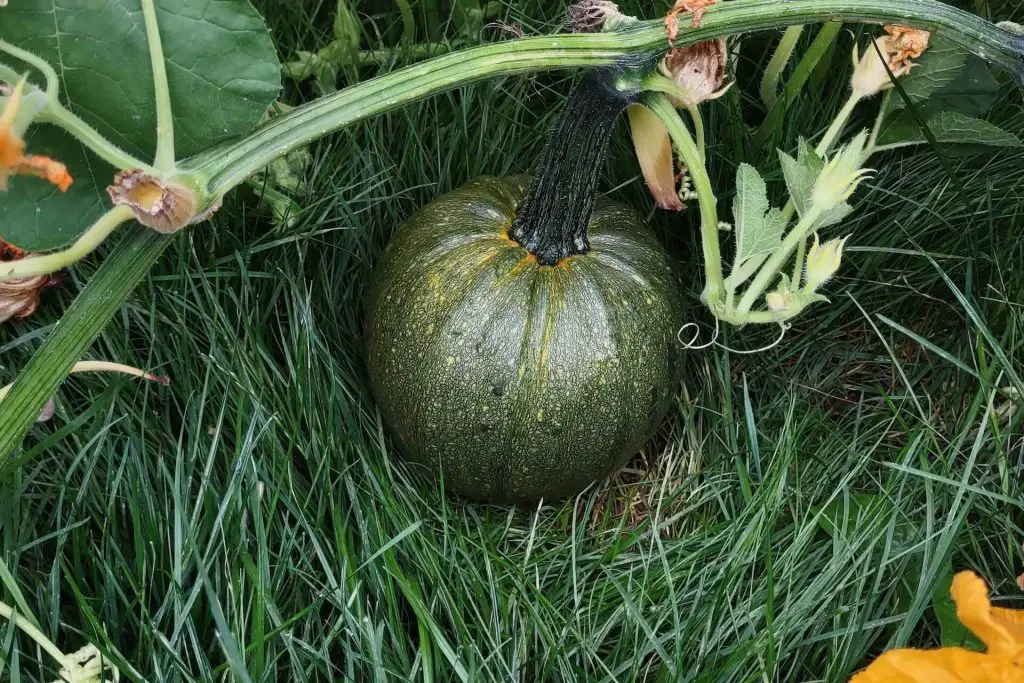
STAGE 6: A Baby Pumpkin Fruit
If you see a baby pumpkin at the base of your pumpkin flower, congratulations! You have a beautiful fruit that is on its way!
After successful pollination, the ovary will enlarge into a baby green pumpkin. It will gradually grow in size, so continue providing nutrients, water, and sunlight regularly. Keep the temperature optimal above 50 ℉.
The pumpkin will get heavier as the weeks go by and will eventually sit on the ground and further ripen from there.
STAGE 7: Colors Of The Pumpkin
Once the pumpkin reaches its true size, it will stop growing and begin changing colors. To get pumpkins to their full shade of color, you need to have all sides of the pumpkin directly under sunlight. This means after tanning one side of the pumpkin, you will need to rotate the pumpkin to the other side to get an even color.
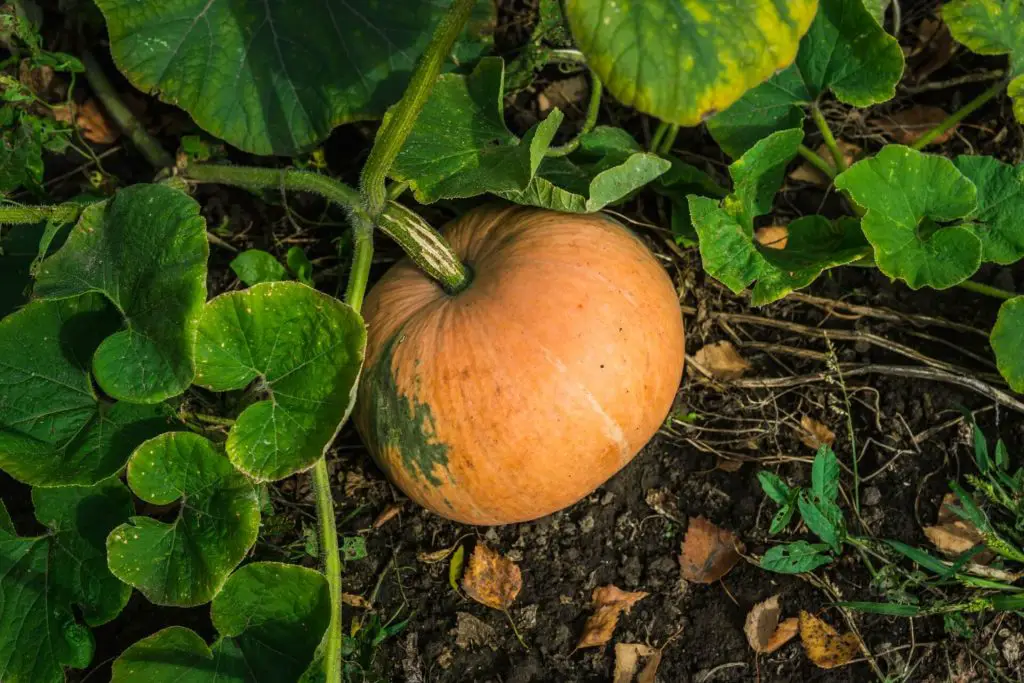
Cut down some of the leaves and vines that may block any sunlight access to your pumpkins. If your pumpkin does not get its full sunlight and it is not rotated, your pumpkin will end up becoming a two-toned pumpkin.
STAGE 8: Harvesting Your Pumpkin
The final stage of the pumpkin growing stages is harvesting your beautiful pumpkins! This is when the plants will wither, making room for the mature pumpkin. At this point, the rinds will be firm and hard.
A good test of a ripe pumpkin is gently knocking on the pumpkin. If the sound is hollow, then your pumpkin is good. Some other indications of a ripe pumpkin depending on your pumpkin’s variety is wart formation on the rinds.
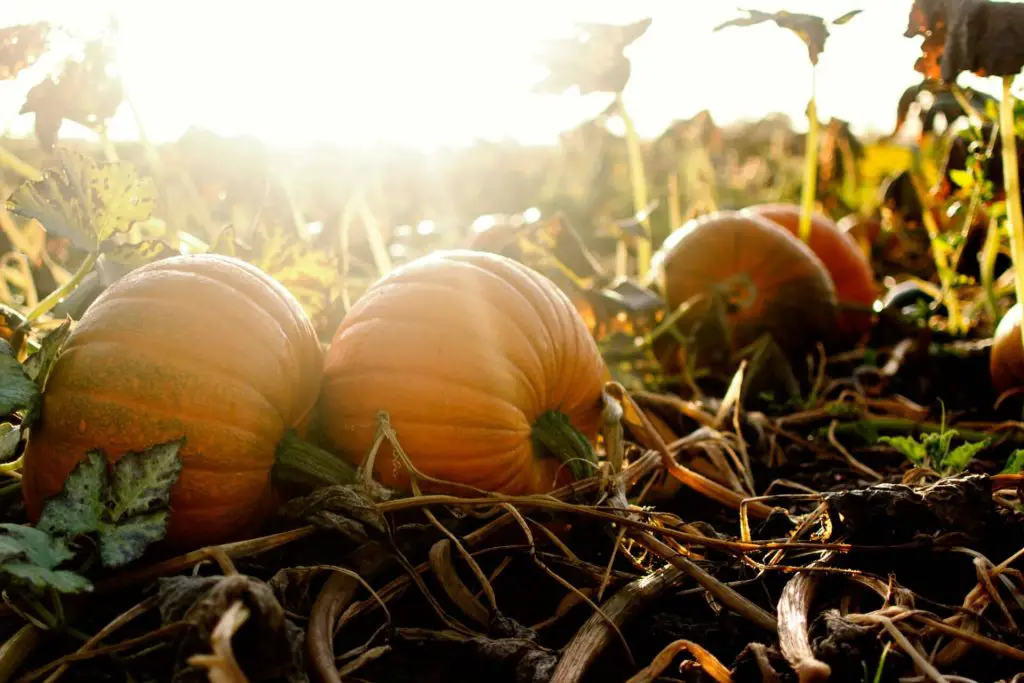
Allow your pumpkin to harden and dry for a couple of weeks before harvesting them for storage. Pumpkins can last up to 4 months with the right maintenance. Store the pumpkin upside down with its stalk facing the bottom.
Place them on a shelf, not on the floor or ground (which can get wet) to prevent rot.
FAQs On Pumpkin Growing Stages
Pumpkin Growing Tips
Pumpkins require sunny and warm weather while shielded from cold, harsh winds and water-retentive soil. This is why pumpkin plants are planted during the summer, between early May to July, when the optimal soil temperature is above 70℉. Space out your pumpkin plants so your pumpkin vines can grow freely.
Do Pumpkins Need A Lot Of Water?
Yes, ripe pumpkins are made out of 80 to 90 percent water, hence, pumpkins require plenty of water for growth. Water your pumpkin plants every 2 to 3 days, especially when the first top inch of soil begins to dry out. You do not want soggy soil, but moist for optimal growth.
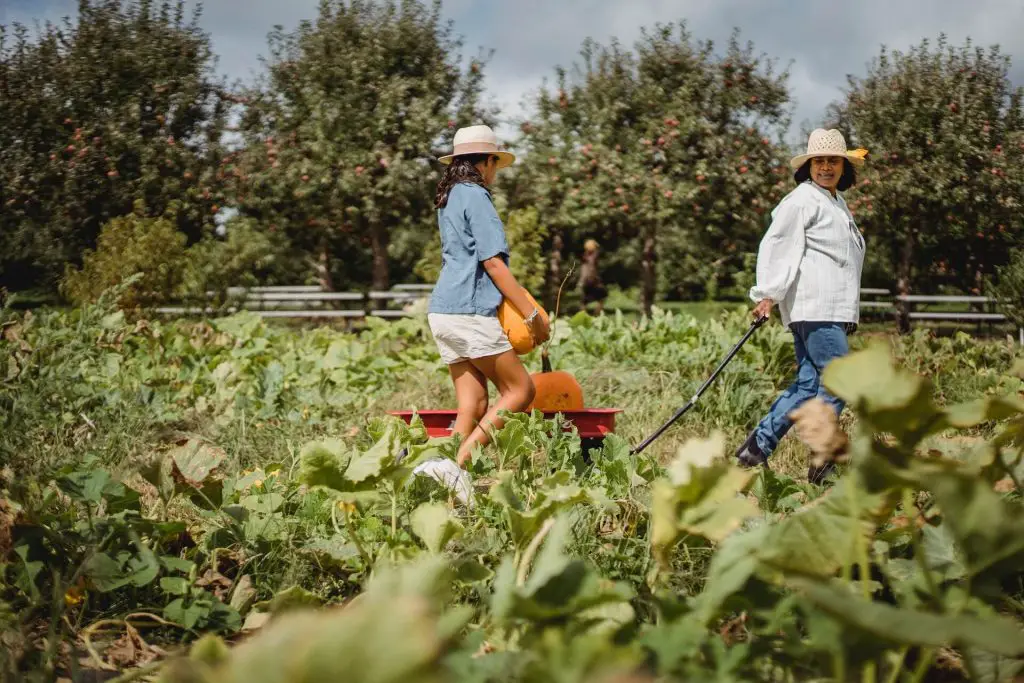
Do Pumpkins Need Full Sun To Grow?
Yes, pumpkins do require at least eight hours of full direct sun daily to grow well. They do not do well with any kind of shade, which will hinder the pumpkin growing process. Find the sunniest spot in your garden to get the maximum warmth and sunlight your pumpkin needs!
How Long Does A Pumpkin Take To Grow?
A pumpkin’s growing time takes around 90 to 120 days to harvest. A pumpkin is ready for harvesting when its rind has turned hardy with a new shade of color. Different varieties of pumpkins have other harvesting times, for example, the timeline for a Big Max pumpkin growing stages is between 110 to 120 days.

What Month Do Pumpkins Start To Grow?
Pumpkins start to grow best in the month of early May through June in time for the fall harvest. In warmer climates, you can plant as late as mid-July. You will also need to take into account the type of pumpkin you are planting, for example, mini pumpkins have a shorter pumpkin growth timeline.
How Many Pumpkins Do You Get Per Plant?
An average pumpkin plant will produce around two to five pumpkins. Typically, plants that have smaller pumpkin variations (< 4 lbs) like Jack Be Little and Baby Boo can go up to twelve pumpkins. A giant pumpkin plant like the Big Max will normally produce one pumpkin as it requires more nutrients and water.
Pumpkin Companion Plants
Your pumpkin plant does not have to be alone in its growing journey! Companion planting with pumpkin is an organic way to keep pests out, especially in its early pumpkin plant stages. Here are the best companion plants for pumpkin:
- Korean Licorice Mint
This particular plant from the mint family will attract beneficial predators like hoverflies that feed on pumpkins’ common pests like aphids and mites. It also deters deers from entering the garden. Mint can also benefit other plants which you can read more about here.
- Marigolds
Plant marigolds as near as possible to your pumpkin plants to weed out nematodes found in the soil. Marigold plants also function as a cover crop to prevent soil erosion.
Should You Prune Pumpkin Vines?
Yes, you should prune pumpkin vines. Although it is not necessary to cut down on the vines, it can boost your pumpkin’s growth as more nutrients will be directed to the fruits, leading to more harvest. Most gardeners will prune pumpkin vines if they want to achieve the largest pumpkin possible from a plant.

How Long Do Pumpkins Take To Grow After Flowering?
It takes around 45 to 55 days for pumpkins to grow after flowering. After the pumpkin plant pollinates successfully, the female flower will gradually change into a pumpkin fruit that will grow in size. The fruit will transform into its full size and a new color depending on your pumpkin variant.
Should I Remove Male Pumpkin Flowers?
Yes, for simplicity, remove all the male flowers after successful pollination. You can identify male flowers with their thin, long stalks whereas female flowers have a bulge at the base. Pumpkins do not self-pollinate, hence male flowers have to provide the pollen to female flowers to grow into baby pumpkins.
Why Does My Pumpkin Plant Have Flowers But No Pumpkins?
Extreme weather conditions may be the main contributor to why your pumpkin plant has flowers but no fruit. Scorching hot and humid weather can cause your plants to dry up whereas heavy rain may flood the soil, damaging the pumpkin plants’ root systems. Sometimes, pests can be the main culprit too!
Conclusion
I hope this post gives you a comprehensive understanding of the pumpkin growing stages. Getting your first pumpkin harvest will be as easy as ABC with the right tender loving care.
I cannot wait for the pumpkins in my yard to grow so I can build my jack-o’-lantern while having a delicious homemade pumpkin pie.
Do you have any additional tips about growing pumpkins? Please share in the comments below so I can learn from you!
If you want to witness a pumpkin growing time-lapse, check out the video below for this giant pumpkin growth stages. (P.S. 600 kg is only half of the world’s heaviest pumpkin!)
Timelapse | From seed to 600kg Giant Pumpkin
Related Posts






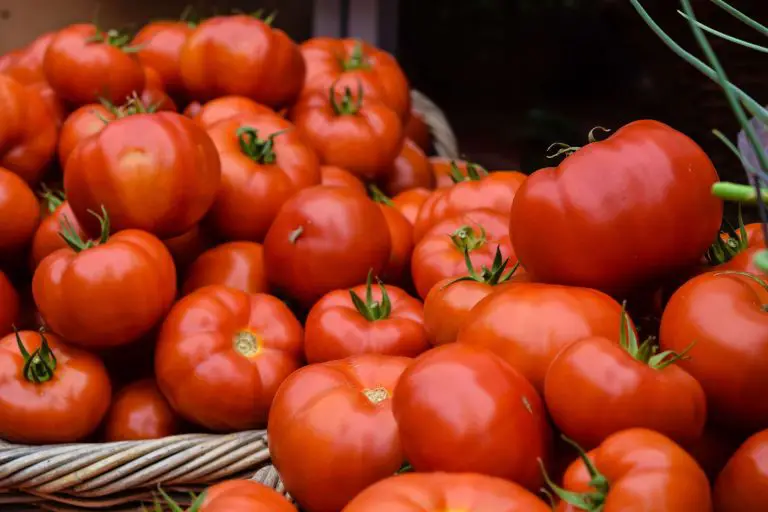
![When To Pick Carrots [+ Harvesting Tips!]](https://aboveandbeyondgardening.com/wp-content/uploads/2021/10/When-To-Pick-Carrots-768x512.jpg)